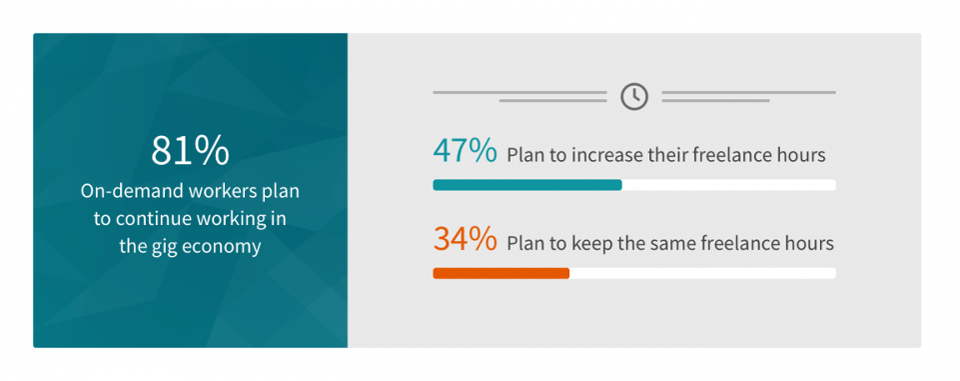What Is Driving The 'Gig' Economy?

Written by Karsten Strauss
Covering the evolution of the jobs market, we’ve touched on the changing nature of employment in the United States. Whether you call it an “agile” workforce or a “gig” economy, the number employees working on a project or contract basis has been on the rise, or so sources insist.
We looked to a recent set of studies from LinkedIn and Intuit – a financial software firm – that sheds a bit of light on why the freelance community has been strengthening in recent years. LinkedIn predicts that by the year 2020, 43% of the U.S. workforce will be made up of workers who freelance—that includes younger workers who love the flexibility of working that way and older ones looking to assert more control over their careers. Though technology is a powerful force in enabling the movement, it is not the only factor at play.
One motivator for those looking to earn more through freelancing is the decline of pension programs, according to LinkedIn. The number of workers enrolled in pension plans at private U.S. firms has fallen from 60% in 1982 to only 14% today. That means less retirement savings and more long-term financial insecurity.
Falling income adds to professional stress as well. Between 2000 and 2012, median family income dropped 8% while the average U.S. rent prices climbed 13%, increasing cost of living.
Unemployment has also influenced job seekers’ decisions to seek opportunities in the freelance market, according to LinkedIn, as the average length of unemployment today is longer than 25 weeks. In the year 2000 it was 12 weeks and in 1980 that average stood at just 8.5 weeks.
LinkedIn also points to the threat to jobs that automation might bring, based on a 2013 report by two Oxford University professors suggesting that developments in machine learning could put as much as 47% of American jobs at risk over the next 20 years.
These conditions could explain what’s motivating even the already employed to take on the freelancer mantle.
“One thing that we’ve seen and been tracking on the LinkedIn side is this rapid rise of part-time freelancers,” says LinkedIn spokesperson, Kenly Walker. “No longer is the traditional nine-to-five job the professional norm. We’re seeing people who have traditional nine-to-five jobs adding this gig work – or part-time freelancing – to their repertoire.”
In watching its members over the past five years, LinkedIn has seen a 100% increase in the number of gainfully employed people who add freelance work to their profiles. Says Walker: “This is a way for (professionals) to take matters into their own hands and proactively have more control over their professional lives.”

LinkedIn’s survey results – based on 9,589 respondents who are members of its ProFinder product – and Intuit’s survey of 6,247 gig economy workers, shows that 57% of freelance workers choose the freelance path to earn more money. Results show that 46% also said they like that working in such a fashion allows them to create and control their own schedules and 35% like the work/life balance that the gig economy provides. Of the freelancers surveyed, 41% say they also have a full time or part-time job in addition to their freelance work.
But are they happy doing what they do? According to the survey, the answers were more positive than not. Overall, 50% of respondents claimed to be highly satisfied, 17% said they were satisfied and 23% were dissatisfied. Another 10% claimed “other.”
Looking ahead, of all those surveyed, 81% said they would continue to work in the gig economy. Of those, 41% intend to increase the freelancing hours and another 34% claimed they would maintain their current level of freelance work. If they are true top their word then this group, at least, will see an uptick in gig activity.
This article was originally published in "Forbes".